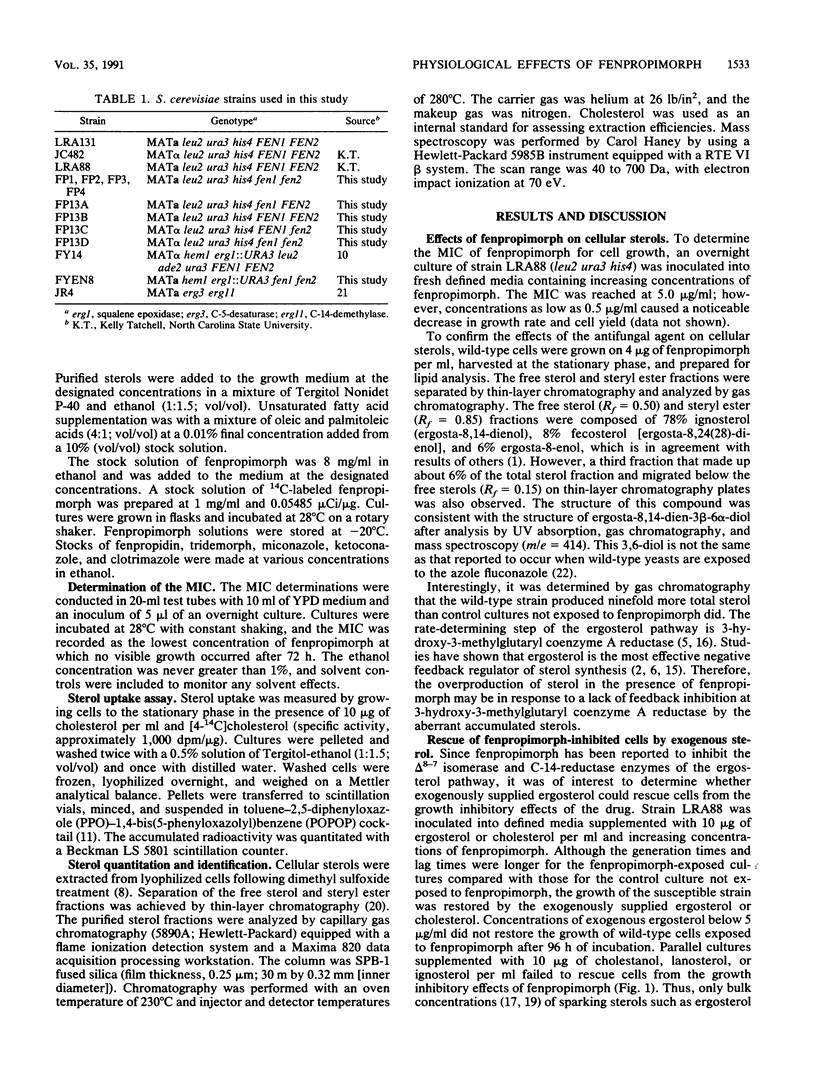Abstract
Fenpropimorph-resistant mutants of Saccharomyces cerevisiae were isolated by a gradient selection procedure. The mutants were cross-resistant to other morpholines (fenpropidin, dodemorph, tridemorph) and 15-azasterol, but were susceptible to azoles (miconazole, clotrimazole, ketoconazole) and nystatin. In the absence of fenpropimorph, the major sterol produced by the mutants and the parental strain was ergosterol. In the presence of fenpropimorph, ignosterol (ergosta-8,14-dien-3 beta-ol) was the major sterol produced by the mutants and the parental strain. The resistance to fenpropimorph involves two recessive genes, each of which allows a semiresistance, when they are isolated apart from one another. Strain JR4 (erg3 erg11), which produces 14-methylfecosterol [14 alpha-methyl-ergosta-8,24(28)-dien- 3-beta-ol) as the major sterol in the presence or absence of fenpropimorph, was also found to be resistant to the drug. The growth inhibitory effect of fenpropimorph on wild-type cells appears to be linked to the production of ignosterol. The uptake of exogenous sterol by wild-type cells was greatly enhanced in the presence of fenpropimorph. The growth inhibition caused by fenpropimorph could only be overcome with bulk levels of exogenous C-5,6-unsaturated sterols.
Full text
PDF





Selected References
These references are in PubMed. This may not be the complete list of references from this article.
- Bard M., Downing J. F. Genetic and biochemical aspects of yeast sterol regulation involving 3-hydroxy-3-methylglutaryl coenzyme A reductase. J Gen Microbiol. 1981 Aug;125(2):415–420. doi: 10.1099/00221287-125-2-415. [DOI] [PubMed] [Google Scholar]
- Boeck L. D., Hoehn M. M., Westhead J. E., Wolter R. K., Thomas D. N. New azasteroidal antifungal antibotics from Geotrichum flavo-brunneum. I. Discovery and fermentation studies. J Antibiot (Tokyo) 1975 Feb;28(2):95–101. doi: 10.7164/antibiotics.28.95. [DOI] [PubMed] [Google Scholar]
- Brown M. S., Goldstein J. L. Multivalent feedback regulation of HMG CoA reductase, a control mechanism coordinating isoprenoid synthesis and cell growth. J Lipid Res. 1980 Jul;21(5):505–517. [PubMed] [Google Scholar]
- Casey W. M., Burgess J. P., Parks L. W. Effect of sterol side-chain structure on the feed-back control of sterol biosynthesis in yeast. Biochim Biophys Acta. 1991 Feb 5;1081(3):279–284. doi: 10.1016/0005-2760(91)90283-n. [DOI] [PubMed] [Google Scholar]
- Hays P. R., Neal W. D., Parks L. W. Physiological effects of an antimycotic azasterol on cultures of Saccharomyces cerevisiae. Antimicrob Agents Chemother. 1977 Aug;12(2):185–191. doi: 10.1128/aac.12.2.185. [DOI] [PMC free article] [PubMed] [Google Scholar]
- Lorenz R. T., Parks L. W. Effects of lovastatin (mevinolin) on sterol levels and on activity of azoles in Saccharomyces cerevisiae. Antimicrob Agents Chemother. 1990 Sep;34(9):1660–1665. doi: 10.1128/aac.34.9.1660. [DOI] [PMC free article] [PubMed] [Google Scholar]
- Lorenz R. T., Parks L. W. Regulation of ergosterol biosynthesis and sterol uptake in a sterol-auxotrophic yeast. J Bacteriol. 1987 Aug;169(8):3707–3711. doi: 10.1128/jb.169.8.3707-3711.1987. [DOI] [PMC free article] [PubMed] [Google Scholar]
- Lorenz R. T., Rodriguez R. J., Lewis T. A., Parks L. W. Characteristics of sterol uptake in Saccharomyces cerevisiae. J Bacteriol. 1986 Sep;167(3):981–985. doi: 10.1128/jb.167.3.981-985.1986. [DOI] [PMC free article] [PubMed] [Google Scholar]
- Marcireau C., Guilloton M., Karst F. In vivo effects of fenpropimorph on the yeast Saccharomyces cerevisiae and determination of the molecular basis of the antifungal property. Antimicrob Agents Chemother. 1990 Jun;34(6):989–993. doi: 10.1128/aac.34.6.989. [DOI] [PMC free article] [PubMed] [Google Scholar]
- Pinto W. J., Lozano R., Nes W. R. Inhibition of sterol biosynthesis by ergosterol and cholesterol in Saccharomyces cerevisiae. Biochim Biophys Acta. 1985 Aug 22;836(1):89–95. doi: 10.1016/0005-2760(85)90224-3. [DOI] [PubMed] [Google Scholar]
- Rodriguez R. J., Low C., Bottema C. D., Parks L. W. Multiple functions for sterols in Saccharomyces cerevisiae. Biochim Biophys Acta. 1985 Dec 4;837(3):336–343. doi: 10.1016/0005-2760(85)90057-8. [DOI] [PubMed] [Google Scholar]
- Rodriguez R. J., Parks L. W. Application of high-performance liquid chromatographic separation of free sterols to the screening of yeast sterol mutants. Anal Biochem. 1982 Jan 1;119(1):200–204. doi: 10.1016/0003-2697(82)90686-8. [DOI] [PubMed] [Google Scholar]
- Rodriguez R. J., Parks L. W. Structural and physiological features of sterols necessary to satisfy bulk membrane and sparking requirements in yeast sterol auxotrophs. Arch Biochem Biophys. 1983 Sep;225(2):861–871. doi: 10.1016/0003-9861(83)90099-1. [DOI] [PubMed] [Google Scholar]
- Skipski V. P., Smolowe A. F., Sullivan R. C., Barclay M. Separation of lipid classes by thin-layer chromatography. Biochim Biophys Acta. 1965 Oct 4;106(2):386–396. doi: 10.1016/0005-2760(65)90047-0. [DOI] [PubMed] [Google Scholar]
- Taylor F. R., Rodriguez R. J., Parks L. W. Relationship between antifungal activity and inhibition of sterol biosynthesis in miconazole, clotrimazole, and 15-azasterol. Antimicrob Agents Chemother. 1983 Apr;23(4):515–521. doi: 10.1128/aac.23.4.515. [DOI] [PMC free article] [PubMed] [Google Scholar]
- Watson P. F., Rose M. E., Ellis S. W., England H., Kelly S. L. Defective sterol C5-6 desaturation and azole resistance: a new hypothesis for the mode of action of azole antifungals. Biochem Biophys Res Commun. 1989 Nov 15;164(3):1170–1175. doi: 10.1016/0006-291x(89)91792-0. [DOI] [PubMed] [Google Scholar]


